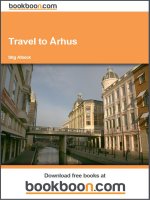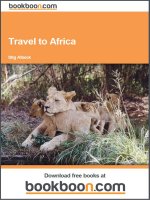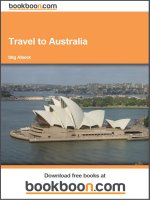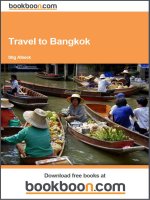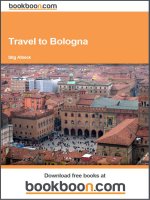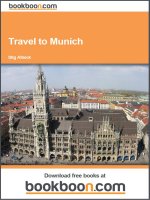Travel to Melbourne potx
Bạn đang xem bản rút gọn của tài liệu. Xem và tải ngay bản đầy đủ của tài liệu tại đây (3.53 MB, 33 trang )
Download free ebooks at bookboon.com
Download free ebooks at bookboon.com
Melbourne
© 2008 Stig Albeck & Ventus Publishing ApS
Translation: Claus Jensen
All rights and copyright relating to the content of this
book are the property of Ventus Publishing ApS, and/or its
suppliers. Content from ths book, may not be reproduced
in any shape or form without prior written permission from
Ventus Publishing ApS.
Quoting this book is allowed when clear references are made,
in relation to reviews are allowed.
ISBN 978-87-7061-321-7
1st edition
Pictures and illustrations in this book are reproduced according
to agreement with the following copyright owners
Panorama (stort format) og Flinders Street Station: Gorm
Albeck. Alle øvrige billeder: Visions of Victoria.
The stated prices and opening hours are indicative and may
have been subject to change after this book was published.
Download free ebooks at bookboon.com
Melbourne
4
Download free ebooks at bookboon.com
Melbourne
5
Melbourne
www.visitmelbourne.com
www.visitvictoria.com
Historical outline
Melbourne area was, like the rest of Australia, originally
inhabited by Australia’s native aboriginals.
The European presence in the area constituting
present day Melbourne began with George Bass’
exploration by sea in 1797, and three years later
James Grant was the next explorer to navigate the
Souhteastern coast of Australia.
Captain Murray was the first to sail into Port
Phillip Bay in 1801, and two years later the entire
bay was explored by Charles Robbins and Charles
Grimes. On that occasion, they sailed up the Yarra
River and arrived at the area which is now
Melbourne’s central part.
In 1803, the first European settlement was
established at the present-day Sorrento on the
Mornington peninsula. But it was soon abandoned,
and it was not until 1834 that the next settlement
was established in Victoria, this time at Portland.
In 1835, the Australian farmer and businessman,
John Batman, sailed from Tasmania to the mouth
of the Yarra River, where he bought 2,430 square
kilometres of land from the aboriginals. Together
with the British, John Pascoe Fawkner, Batman
founded Melbourne, which was named after the
Bristish Prime Minister William Lamb, who bore
the title 2nd Viscount Melbourne.
In 1837, Robert Hoddle established a city plan; he
laid out the new city after a strict pattern with
carefully measured, perpendicular streets.
Governor Gipp’s intention in choosing this
arrangement was to get the land ready to be sold
for development as quickly as possible. One of the
plan’s curiosities is the lack of city squares and
markets, which were all left out on Gipp’s orders.
He thought this would help bring people together
and promote democracy.
The following year, the pace accelerated. Several
land sales were held in the city, and in 1838 the
harbour opened, which made possible immigration
in high numbers. Within the next decade, several
public institutions were established, among them a
hospital. In 1836 only 200 people were living in the
area, but by 1850 the number had grown to 25,000.
The year 1851 became a milestone for Melbourne:
With the city as the central part, Victoria became an
independent colony, separate from New South Wales.
Soon after, gold was discovered in Ballarat, west of
Melbourne, and this caused widespread gold fever.
The gold fever led to an explosive growth in
immigration, and in just a few years the population
grew to 250,000. During this time, a third of the
world’s gold was mined in the State of Victoria.
General development accompanied the growing
population and the wealth created by the gold. In
1852, a gas plant was opened, and two years later
the first Flinders Street railway station was built. A
university, a state library, a telegraph office and the
City Hall are but a few of the many stately
buildings that were erected in the 1850s.
Melbourne expanded culturally as well. The city’s
museum was founded in 1855, and six years later
the first horse race, the Melbourne Cup, was held.
That year the city also hosted the State of
Victoria’s great exhibition.
Melbourne
Download free ebooks at bookboon.com
Melbourne
6
The last decades of the 19th century saw virtually
uninterrupted growth. The population grew and
new large public and private developments were
constantly being initiated. In 1885, the first cable
tram line was opened, and today Melbourne is
famous for its many tram cars. In this period,
Melbourne was the industrial and economic centre,
and it was the home of the Australian colonies’
political administration.
The new nation, the Commonwealth of Australia,
was established in 1901 by agreement of all the
Australian states. Both Sydney, which had grown
strongly and was enjoying great commercial
success, and Melbourne laid claim to the title of
capital. Canberra, situated between the two large
cities, was chosen as a compromise. Two new
government buildings had to be built, so
Melbourne remained the de facto capital until the
Parliament stood ready in 1927.
The first half of the 20th century saw hardship, for
Melbourne as for the rest of the country. Australia
sent more than 100,000 soldiers to fight in the
First World War, and later came the Great
Depression followed by the Second World War, in
which Australian troops fought as well.
After the Second World War, a new wave of
immigrants arrived in Melbourne. In the 1950s and
1960s, many Greeks and Italians came to the city,
and they continue to leave their mark on the city
today. Apart from the internationalization
accompanying the large immigration, Melbourne
also enjoyed worldwide attention as the host of the
1956 Olympic Games.
In the 1970s, many Asian immigrants began to
arrive in Melbourne, and recently North Africans
in particular have begun to settle in the now very
cosmopolitan city with a population of more than
3.5 million.
At the end of the 19th century, restoration of the
old, deteriorating harbour areas, Docklands, was
commenced. They were imbued with an exciting
modern atmosphere, including various activities
and restaurants. Modern skyscrapers mushroomed
in several places in the city, notably along the
Yarra River. These are but some of the many
delightful places in Melbourne’s open and lively
neighbourhoods.
Melbourne
Download free ebooks at bookboon.com
Please click the advert
Melbourne
7
Tour 1: Melbourne
1. Circle Tram Line
Station: Flagstaff/Flinders
Street/Parliament/Melbourne Central
www.tramrestaurant.com.au
A tram line for tourists circles the central quarters
of Melbourne. It is possible to get on at many
places along the route, which offers an excellent
introduction to the city. Melbourne’s old tram cars
are very evocative, and they are known everywhere
in Australia.
2. Melbourne Observation Deck
Collins Street 525
Station: Spencer Street
www.melbournedeck.com.au
Melbourne Observation Deck is the best
viewpoint in the city. It is situated on the 55th
floor of Rialto Towers, which is the southern
hemisphere’s tallest office building.
Tour 1: Melbourne
Download free ebooks at bookboon.com
Melbourne
8
Rialto Towers, built 1982-1986, measures 253
metres tall. The Observation Deck opened in 1994.
It takes 40 seconds to get to the top by elevator, or
1254 steps using the stairs. On clear days, visibility
is 60 km, and the Observation Deck offers a
beautiful view of central Melbourne.
3. The Block Arcade
Collins Street 282
Station: Flinders Street
Melbourne has a number of beautiful historic
shopping arcades, but the most beautiful is The
Block Arcade from 1892. The Arcade still houses
various shops as well as a tea house, the Hopetoun
Tea Rooms, which has a very rich tradition.
4. GPO Melbourne
Elizabeth Street
Station: Melbourne Central
www.melbournesgpo.com
GPO Melbourne is a modern shopping centre
situated in the city’s former post office, the
General Post Office. The building, one of
Melbourne’s most characteristic, was built in the
1870s.
5. Chinatown
Little Bourke Street mellan Swanston Street
och Exhibition Street
Station: Melbourne Central
Melbourne’s Chinatown constitutes a colourful
and lively section of Little Burke Street. Some of
the city’s Chinese immigrants operate shops and
restaurants there.
6. Old Melbourne Gaol
Russell Street
Station: Melbourne Central
www.nattrust.com.au
Old Melbourne Gaol is Melbourne’s best
preserved jail, as well as one of the oldest buildings
in the city.
Throughout its history, a total of 136 people were
hanged in the gaol, among them the feared
bushranger Ned Kelly, known as the Man with the
Iron Mask.
The gaol closed in 1926, and it is now a museum
detailing prison life in the 19th century. Walking
down the long corridors, the visitor can view
exhibits such as a death mask. Ghostly night tours
by candlelight can also be arranged.
Tour 1: Melbourne
Download free ebooks at bookboon.com
Melbourne
9
7. Melbourne Museum
Nicholson Street 11, Carlton Gardens
Station: Parliament
www.melbourne.museum.vic.gov.au
The large, impressive Melbourne Museum uses
modern technology to a large extent in presenting
its collection detailing Australia’s flora, fauna and
culture. The museum also has a special exhibition
about Melbourne’s history.
The Evolution Gallery is a fascinating exhibition
showing the evolution of life on Earth. Among the
exhibits are five dinosaur skeletons. The visitor
can also experience a tropical rain forest.
The museum houses the stuffed remains of the
thoroughbred Phar Lap, viewed by many as the
greatest race horse of all time. Phar Lap was born in
1926 in New Zealand, and died under mysterious
circumstances in 1932 in California. The legendary
horse won 37 out the 52 races it entered.
The museum’s modernistic architectural style has
made it one of Australia’s most famous buildings.
8. Royal Exhibition Building
Carlton Gardens
Station: Parliament
www.museum.vic.gov.au/reb
The impressive Royal Exhibition Building was
finished in 1880 as part of the Melbourne
International Exhibition. The style was inspired by
Florentine cathedrals.
In 1901, the building hosted the opening of
Australia’s first Parliament as an independent state.
Later, it became home of the State of Victoria’s
Parliament for several years.
In 2004, the Royal Exhibition Building was added
to UNESCO’s list of world heritage sites as one of
the 19th century’s few surviving fashionable
exhibition buildings.
9. Parliament of Victoria
Spring Street 157
Station: Parliament
www.parliament.vic.gov.au
The State of Victoria’s Parliament buildings are
considered the most beautiful in Australia. The
style is elegantly classicistic with a large stairwell
turning towards Spring Street and Melbourne. The
surrounding park is also very impressive; when
visiting the Parliament Building, one should not
miss the outdoor facilities.
10. City Museum
Spring Street 20
Station: Parliament
www.citymuseummelbourne.org
The City Museum showcases Melbourne’s history,
architecture, culture and modern life-style. The
building itself is of historical interest. It was built
as the National Bank of Britain’s Australian colony,
called Old Treasury, and the vaults for storing the
Australian gold reserves can still be viewed.
Tour 1: Melbourne
Download free ebooks at bookboon.com
Please click the advert
Melbourne
10
11. Cook’s Cottage
Wellington Parade Street, Fitzroy Gardens
Station: West Richmond
www.fitzroygardens.com
Cook’s Cottage was originally built in 1755 in
England by James and Grace Cook, the parents of
the famous explorer Captain Cook. In 1927, Sir
Russel Grimwade bought the house, dismantled it
and had it rebuilt in 1934 in Melbourne’s Fitzroy
Park in connection with the 100th anniversary of
the European presence in the region.
Visiting the house gives a good impression of the
18th century and of Captain Cook’s life and
explorations.
In the Fitzroy Gardens nearby Cook’s Cottage lies
a model Tudor village. It was donated by English
cities in appreciation of Melbourne’s assistance
during the Second World War. The model village
was built in cement by the Englishman Edgar
Wilson and it opened in 1948.
12. Melbourne and Olympic Parks
Batman Avenue
Station: Richmond
www.mopt.com.au
Melbourne Park and Olympic Park constitute the
largest area in the city for sports events, concerts
etc. Every year in January, the first Grand Slam
tennis tournament is played in Melbourne Park. It
is the historic Australian Open, which was held for
the first time in 1905. The main court of the
tournament is the Rod Laver Arena, which was
built in 1968. It has room for more than 15,000
spectators. Olympic Park was host of the 1956
Olympic Games, which were held in Melbourne.
The facilities can be viewed on a tour which takes
the visitor through corridors full of exhibits from
the many star-studded events and inside the
changing rooms of the stars. The visitor also gains
insight into the technical aspects of getting
through an event like Australian Open.
Tour 1: Melbourne
© Deloitte & Touche LLP and affiliated entities.
360°
thinking
.
Discover the truth at www.deloitte.ca/careers
© Deloitte & Touche LLP and affiliated entities.
360°
thinking
.
Discover the truth at www.deloitte.ca/careers
© Deloitte & Touche LLP and affiliated entities.
360°
thinking
.
Discover the truth at www.deloitte.ca/careers
© Deloitte & Touche LLP and affiliated entities.
360°
thinking
.
Discover the truth at www.deloitte.ca/careers
Download free ebooks at bookboon.com
Melbourne
11
Tour 1: Melbourne
Download free ebooks at bookboon.com
Melbourne
12
Tour 2: Melbourne
13. Melbourne Maritime Museum
South Wharf Road
Station: Spencer Street
www.melbournemaritimemuseum.com.au
In the Melbourne Maritime Museum, the maritime
history of the State of Victoria is exhibited. The
Museum’s biggest attraction is the three-masted
barque Polly Woodside, which lies in one of the
city’s old historical docks. Polly Woodside was
built in 1885 and has been reconstructed in its
original form.
There is also a comprehensive description of the
river traffic, the city’s harbour and the importance
of navigation for Melbourne’s development,
notably as it relates to immigration.
14. Immigration Museum
Flinders Street 400
Station: Flinders Street
www.immigration.museum.vic.gov.au
At the Immigration Museum, the stories are told
of people from all over the world who migrated to
the State of Victoria, from the 18th century up
until present day. Many lives are detailed through
stories, pictures, personal effects and other
information. There is also a 17 metres long
reconstruction of one of the ships that brought
people across the oceans to Australia.
15. Flinders Street Station
Flinders Street
Station: Flinders Street
Melbourne’s Railway Station in Flinders Street is
the oldest of Australia’s large station buildings.The
railway station is built in a palatial style, and it is
one of Australia’s busiest.
The first station building was built in 1854, but the
need for an extension became apparent after a few
years. In 1882 the decision was made to add to the
building, but the station was not opened until 1910.
16. St. Paul’s Cathedral
Swanston Street/Flinders Street
www.stpaulscathedral.org.au
Station: Flinders Street
St. Paul’s Cathedral is Melbourne’s Anglican
cathedral. The building was opened in 1891, at
which time it was Melbourne’s tallest building,
dominating the skyline of the city.
The architectural style exhibits traits of neo-
Gothicism, but there are also some decorative
elements, as in the other major buildings from this
period, and the interior of the church is quite beautiful.
Tour 2: Melbourne
Download free ebooks at bookboon.com
Please click the advert
Melbourne
13
17. Federation Square
Federation Square
Station: Flinders Street
www.fedsquare.com
The newly finished Federation Square is one of the
most unique experiences in Melbourne. The
square is dominated by buildings in an original
style, and by the many activities taking place there.
At the Federation Square lies the Australian Centre
for the Moving Image, which details the history of
Australian film-making and shows a rich variety of
Australian movies. Visitors can also experience the
world of horse racing at the museum, at the
Champions, the Australian Racing Museum and
Hall of Fame.
From the nearby skyscraper, Eureka Tower,
featuring the observation deck, Skydeck, the
visitor has the opportunity to view the area from
above.
17a. The Ian Potter Centre, National Gallery of
Victoria
www.ngv.vic.gov.au
In the mid-1990s, the decision was made to build a
new home for the National Gallery of Victoria, which
had grown too large for the premises on St. Kilda
Road. The Ian Potter Centre was established, and it
now houses the museum’s Australian collection
Tour 2: Melbourne
Increase your impact with MSM Executive Education
For more information, visit www.msm.nl or contact us at +31 43 38 70 808
or via
the globally networked management school
For more information, visit www.msm.nl or contact us at +31 43 38 70 808 or via
For almost 60 years Maastricht School of Management has been enhancing the management capacity
of professionals and organizations around the world through state-of-the-art management education.
Our broad range of Open Enrollment Executive Programs offers you a unique interactive, stimulating and
multicultural learning experience.
Be prepared for tomorrow’s management challenges and apply today.
Executive Education-170x115-B2.indd 1 18-08-11 15:13
Download free ebooks at bookboon.com
Melbourne
14
18. National Gallery of Victoria
St. Kilda Road 180
Station: Flinders Street
www.ngv.vic.gov.au
The National Gallery of Victoria has held
international art exhibitions in its main building
since 1861. In addition to its impressive
international collection, the museum hosts various
other exhibitions. The works of countless artists
have been exhibited there, among them René
Magritte, El Greco, and Rembrandt.
19. River Boat
Southgate Promenade
Station: Flinders Street
www.melbcruises.com.au
A boat trip on the Yarra River is a wonderful
experience. The river runs through some of
Melbourne’s many green areas, straight through the
modern quarters in the city centre and South Bank
and on to the newly developed Docklands area.
20. The Arts Centre
St. Kilda Road 100
Station: Flinders Street
www.theartscentre.net.au
The architecturally fascinating Arts Centre is one
of Melbourne’s foremost cultural institutions, with
a wealth of offerings for the visitor, such as theatre,
opera, outdoor concerts and art exhibitions.
21. Shrine of Remembrance
St. Kilda Road
Station: Flinders Street
www.shrine.org.au
The Shrine of Remembrance, the memorial shrine
for the State of Victoria’s 114,000 men and
women who participated in the First World War, is
perhaps Melbourne’s most characteristic building.
Of the 89,000 Australians who served abroad,
19,000 never returned. The central monument was
built during 1928-1934, but additions were made
in connection with wars and conflicts taking place
after the First World War.
After the Second World War, the Eternal Flame
was lit, and the Remembrance Garden was built in
memory of post-1945 armed conflicts, such as the
Korean War and Vietnam War.
22. Government House
Parliament Place 4
Station: Flinders Street
www.nattrust.com.au
The Government House is the official residence
for the State of Victoria’s governor. The style was
inspired by Italian architecture, and when it
opened it was one of Victoria’s most distinguished
buildings.
Tour 2: Melbourne
Download free ebooks at bookboon.com
Melbourne
15
Government House is open to visitors. Tours start
in La Trobe’s Cottage, which is on the corner of
Birdwood Avenue and Dallas Brook Drive.
23. Royal Botanic Gardens
Birdwood Avenue, South Yarra
Station: Flinders Street
www.rbg.vic.gov.au
Melbourne’s Royal Botanic Gardens, with their
wealth of different plants, large lawns and
delightful lakes, are considered among the most
beautiful in the world.
Melbourne’s modern skyscrapers provide a
fascinating backdrop to the occasionally rather
dense vegetation.
24. Como Historic House & Garden
Williams Road/Lechlade Avenue, South Yarra
Station: Hawksburn
www.nattrust.com.au
The beautiful colonial-style mansion, Como House,
offers the visitor an insight into the life-style of the
privileged classes around the year1900. In addition
to the main building, the garden facilities are very
charming with their lawns, flower beds, lakes and
many trees.
Tour 2: Melbourne
Download free ebooks at bookboon.com
Please click the advert
Melbourne
16
Day Tours from
Melbourne
25. Rippon Lea Estate
Hotham Street 192, Elsternwick, 8 km Southeast
www.nattrust.com.au
Sir Frederick Thomas Sargood had this large
beautiful mansion built in a distinguished
Victorian style in 1868-1903. In the 1930s, several
additions were made, including the great hall. The
mansion’s greatest attraction is the surrounding 5
hectares of garden landscape, beautifully arranged with
lots of flowerbeds, a lake and a tower, from the top of
which one has an excellent view of the facilities.
26. Phillip Island Penguin Parade
Phillip Island, 100 km SÖ
www.penguins.org.au
On Philip Island, the visitor can experience the
fascinating penguins inhabiting the small island
and their daily rituals. On Summerland Beach at
sunset, scores of penguins will come waddling up
out of the ocean and across the beach to the sand
dunes where they spend the night.
Day Tours from Melbourne
Get “Bookboon’s Free Media Advice”
See the light!
The sooner you realize we are right,
the sooner your life will get better!
A bit over the top? Yes we know!
We are just that sure that we can make your
media activities more effective.
Download free ebooks at bookboon.com
Melbourne
17
The ritual occurs every night with clockwork
precision, and the penguins pay no heed to the
many visitors watching the unique phenomenon
every day.
Next to Summerland Beach lies an information
centre where visitors can learn about the penguins
and their life.
But Phillips Island’s animal attractions comprise
more than its penguins. In the Vestnor Koala
Reserve and in the Koala Conservation Centre it is
possible to watch koala bears in the trees, in the
Phillip Island Wildlife Park visitors can get close to
animals such as kangaroos, and seals can be viewed
at the Seal Rocks on the island’s western tip.
Yet another attraction, the island’s vineyards are
found at the Philip Island Winery.
27. Great Ocean Road
200 km Southwest
www.greatoceanrd.org.au
The Great Ocean Road is a beautiful stretch along
the southwestern coast of the State of Victoria.
The route goes through historical cities, delightful
beaches, forests and incredible rock formations.
Among the historical cities are Portland, the oldest
European settlement in Victoria, Camperdown,
Port Fairy and Queenscliff.
The Otway Fly is another fascinating experience. It
is a 600 metres long tree-top walk 25 metres in the
air. The Otway Fly can be reached from Apollo
Bay via the Great Ocean Road.
27a. Twelve Apostles
The rock formations of the Twelve Apostles are
the Great Ocean Road’s landmark. The 45 metres
tall rocks lie spread out next to the 70 metres tall
coastal cliffs like, stones thrown into the waterby a
giant. The Twelve Apostles have been shaped by
the ocean during the past 20 million years. The
fascinating scenery can be viewed from several
well-placed viewpoints.
To the west of the Twelve Apostles lies the Loch
Ard Gorge, whose treacherous coast is infamous
for the many shipwrecks it has caused, and the
rock formation London Bridge.
Day Tours from Melbourne
Download free ebooks at bookboon.com
Melbourne
18
28. Grampians National Park
225 km Northwest
www.parkweb.vic.gov.au
The Grampians National Park offers a possibility
to experience Australia’s magnificent nature.
Visitors can climb over naked crags while admiring
the view of green-clad mountains and roaring
waterfalls. Among the most beautiful sights in the
park are the many wildflowers growing in several
places along the nature trails.
The information centre in Halls Gap is a good
place to start the trip.
29. Ballarat
120 km Northwest
www.visitballarat.com.au
The city of Ballarat has played a large part in
Melbourne’s development; it was here that gold
was discovered in 1851. More than 20,000 people
came to the city in search of gold and fortune, and
the entire region around Ballarat prospered.
Several beautiful buildings have been erected in
the city through the years, for example Her
Majesty’s Theatre from 1875 and Craig’s Royal
Hotel from 1862. In Ballarat lies also Lake
Wendouree, where the 1956 Olympic rowing
competitions were held.
29a. Sovereign Hill
www.sovereignhill.com.au
Sovereign Hill is a historical restoration from the
time when Ballarat was a mining town. Visitors
can try their hand at panning gold, watch the
Western Highway Stage Coach and visit the many
stores of the middle of the 19th century. It is quite
like being part of a Western movie.
30. Dandenong Ranges
50 km East
www.bluedandenongs.com.au
The Dandenongs is a low mountain range with a
maximum height of 660 metres on Mount
Dandenong. The natural scenery of the range is
magnificent, including the large temperate rain
forests and eucalyptus groves.
Day Tours from Melbourne
Download free ebooks at bookboon.com
Please click the advert
Melbourne
19
30a. Puffing Billy Steam Train
www.puffingbilly.com.au
Puffing Billy is a historic narrow gauge railroad
running through the Dandenongs. The railroad
was opened in 1900 to transport timber, among
other things. The railroad originally went from
Upper Fern Tree Gully Station, but today it starts
at Belgrave Station.
The line was taken over by Victorian Railways,
who discontinued it in 1954. A historic railroad
society was founded that has since maintained the
line, which today is 24 kilometres long. The rolling
stock comprises the charming old steam engines with
their carriages. The stretch is fantastically beautiful,
leading deep into pristine jungle-like forest.
Day Tours from Melbourne
GO T -THE-ENERGY-T O-LEAD.C OM
We believe that energy suppliers should be renewable, too. We are therefore looking for enthusiastic
new colleagues with plenty of ideas who want to join RWE in changing the world. Visit us online to find
out what we are offering and how we are working together to ensure the energy of the future.
Download free ebooks at bookboon.com
Melbourne
20
31. Yarra Valley
50 km Northeast
www.visityarravalley.com.au
The Yarra Valley is one of the State of Victoria’s
largest and richest wine-producing areas with more
than 40 vineyards situated in the green undulating
landscape.
It is possible to visit the vineyards, view the
facilities, learn about wine production and of
course taste the many different wines made there.
Visiting the Yarra Valley can be a culinary pleasure
as well if one makes sure to include some of the
restaurants associated with the vineyards.
Day Tours from Melbourne
Download free ebooks at bookboon.com
Melbourne
21
With children in Melbourne
Melbourne Zoo (Elliott Avenue, Parkville):
www.zoo.org.au
Melbourne Aquarium
(Queenswharf Road/Kings Street):
www.melbourneaquarium.com.au
Luna Park (Lower Esplanade, St. Kilda South):
www.lunapark.com.au
Scienceworks & Planetarium (Booker Street 2,
Spotswood):
www.scienceworks.museum.vic.gov.au
Shopping in Melbourne
Bourke Street Mall, Bridge Road, Collins Street,
Flinders Lane, Southgate
Chadstone Shopping Centre (Monash
Freeway/Princes Highway):
www.chadstoneshopping.com.au
GPO Melbourne (Elizabeth Street):
www.melbournesgpo.com
Highpoint (Maribyrnong):
www.highpoint.com.au
Knox City (Burwood Highway):
www.knoxshoppingcentre.com.au
Melbourne Central
(LaTrobe Street/Swanston Street):
www.melbournecentral.com.au
Queen Victoria Village
(Lonsdale Street/Swanston Street)):
www.qv.com.au
The Block Arcade (Collins Street 282)
Westfield Southland
(Nepean Highway 1239, Cheltenham):
www.westfield.com/southland
Public transportation in Melbourne
Melbourne city transportation:
www.metlinkmelbourne.com.au
Melbourne Airport:
www.melair.com.au
Children / Shopping / Transportation
Download free ebooks at bookboon.com
Please click the advert
Melbourne
22
Train Map
Train Map
Contact us to hear more
Who is your target group?
And how can we reach them?
At Bookboon, you can segment the exact right
audience for your advertising campaign.
Our eBooks offer in-book advertising spot to reach
the right candidate.
Download free ebooks at bookboon.com
Melbourne
23
Facts about Australia
Politics
Official name Commonwealth of Australia
Capital Canberra
System of government Federal Constitutional Monarchy
Head of state Queen Elizabeth II
Head of government Prime Minister John Howard
National Holiday 26 January
Independence achieved 1 January 1901 from Great Britain
Primary religion Christianity
Language English
Area 7,741,220 km²
Population (2007) 21,097,000
Borders on
North The Indian Ocean, the Timor Sea, the Arafura Sea, Gulf of
Carpentaria, the Coral Sea
South The Indian Ocean, the Great Australian Bight, the
Tasmanian Sea
East The Tasmanian Sea, the Coral Sea
West The Indian Ocean
Facts about Australia
Download free ebooks at bookboon.com
Please click the advert
Melbourne
24
Tallest Mountains
Mount Kosciuszko 7310 ft (2,228 m)
Mount Townsend 7247 ft (2,209 m)
Mount Twynam 7201 ft (2,195 m)
Rams Head 7185 ft (2,190 m)
Unnamed peak in Etheridge Ridge 7152 ft (2,180 m)
Rams Head North 7142 ft (2,177 m)
Alice Rawson Peak 7087 ft (2,160 m)
Unnamed peak by Abbott Peak 7083 ft (2,159 m)
Abbott Peak and Carruthers Peak 7037 ft (2,145 m)
Mt Northcote 6991 ft (2,131 m)
*The tallest mountain in the Australian Territories is, with its 9006 ft (2.745 m), Mawson’s Peak on Heard Island.
Facts about Australia
THE BEST MASTER
IN THE NETHERLANDS
Download free ebooks at bookboon.com
Melbourne
25
Largest islands
Tasmanien 60 637 km²
Melville Island 5 786 km²
Kangaroo Island 4 416 km²
Groote Eylandt 2 285 km²
Bathurst Island 1 693 km²
Fraser Island 1 653 km²
Flinders Island 1 359 km²
King Island 1 091 km²
Mornington Island 1 002 km²
Largest lakes
Lake Eyre 9 500 km²
Lake Torrens 5 900 km²
Lake Gairdner 4 300 km²
Lake Frome 2 685 km²
Longest rivers
Murray 1566 mi (2,520 km)
Murrumbidgee River 979 mi (1,575 km)
Darling River 864 mi (1,390 km)
Lachlan River 851 mi (1,370 km)
Flinders River 521 mi (840 km)
Gascoyne River 472 mi (760 km)
Goulburn River 352 mi (566 km)
Victoria River 348 mi (560 km)
Facts about Australia
